Evan Kalish’s Wall Street Journal crossword, “Level Up” — Jim P’s review
I have to admit I wasn’t paying very close attention to this puzzle while solving. I did it on my phone while sitting in a Menchie’s waiting for my daughter to finish her too-full tub of frozen yogurt. It took us about the same amount of time.
My phone app didn’t show any circles, so I was surprised by the revealer at 52d: [With 61-Down, global warming consequence, and a hint to the circled letters]. Not seeing any circled letters, I finished the solve as if it was themeless.
Looking back now, I can see why RISING / SEAS was not making much sense; these would be hard to find without the circles. Each set of circles spells out the name of a world sea going up diagonally to the right. In order, we have DEAD (Middle East), YELLOW (East Asia), BLACK (Eastern Europe), NORTH (Western Europe), and CORAL (Australia).
Nicely done. Even though I didn’t need them to solve the grid, it was a nice surprise to finally see these thematic elements. And even though they’re short and there are no other constraints in the Across or Down directions, these definitely do put constraints on every part of the grid.
Because of that, there aren’t any what I’d call “marquee” entries in the fill. We do get a clutch of nice 8s though, like STRANGER, SCREENER, STEEL TOE, and GOTTA RUN.
Oh, and LAWN DART [Projectile banned by the Consumer Product Safety Commission]. I can see why. When I was in 3rd grade I nearly killed (or at least seriously hurt) my friend Bobby with one of these. I threw it way high up in the air (it seemed to me) and then, being a stupid kid, got distracted by something else. Thankfully Bobby saw it at the last second and jumped out of the way, but it was a close one. It was the actual death of a girl that did lead to the banning of this product. And there was no LAWN DART lobby around to fight it. Remember, people don’t kill people, lawn darts kill people.
I also thought it was really interesting to see LIDAR [Modern speed-detection system] in the grid. My brother works for Velodyne LIDAR developing the technologies that will allow vehicle-to-vehicle and vehicle-to-infrastructure communications, so I’m sure he’d get a kick out of this…if he did crosswords.
There are some challenging bits as well, especially NEPHRON [Kidney unit] for which I needed just about every cross. Amy, can you give us a ruling on this word? {Amy says: That’s solid. You’re lucky you weren’t asked to come up with GLOMERULUS or PODOCYTE.}
Some other entries that raised my eyebrows were:
- ADDY [Email contact info, informally]. Never heard this, and I’m not sure I would ever want to.
- LANYARD is partially adjacent to YARD. Anyone want to look up the etymology of the former?
- I’m really dubious of EISNER [Iger’s predecessor at Disney] as an entry anymore. I feel it lacks currency.
All in all, a fairly nice construction and a well-executed theme. 3.7 stars.
Byron Walden’s New York Times crossword—Amy’s write-up
This 15×16 grid is elongated to include a central pair of themers to go with the top and bottom pairs. Our revealer is in a weird spot: 7d. [URL ending associated with the beginnings of the answers to the six starred clues], EDU. Those theme answers begin with the names of a college and five universities:
- 12a. [*Instructions for premade dinner rolls], BROWN AND SERVE. Most brands seem to be labeled “Brown ‘N Serve,” and the instructions will generally tell you to bake until golden brown, not just “brown” the rolls. *side eye*
- 14a. [*Noble couple], DUKE AND DUCHESS.
- 31a. [*Latin American side dish that combines two food staples], RICE AND BEANS.
- 34a. [*Title pair in a 2004-07 Nickelodeon sitcom], DRAKE AND JOSH. The show’s title was Drake & Josh, hence the hedge in the clue’s wording.
- 53a. [*Eponymous founders of a Massachusetts-based firearms manufacturer], SMITH AND WESSON. Another clue hedge, as the company is called Smith & Wesson.
- 58a. [*Duo of magicians who are the longest-running headliners in Las Vegas history], PENN AND TELLER. As an act, they’re Penn & Teller, but the clue doesn’t precisely specify. The other school names are ___ College or ___ University, but Penn is the University of Pennsylvania—and if you type in penn.edu, you’re not on Penn’s site. Their URL is upenn.edu. That “associated with the beginnings of the answers” hedge in the revealer clue feels like a kludge to me.
Between the and/’n/ampersand issues and upenn.edu, I have to dock the theme some points. It looks cool to have three stacked pairs of theme entries, but it’d be better if the theme itself were rock solid.
Fave fill: BURGLE, because it sounds funny. ORESTEIA, because literature and the classics. BANJO/MOJO, two words that don’t go together (and do not intersect at the J!). AMARETTO, TWERKS, TAG TEAMS.
Name I’m not sure if anyone younger than me knows, unless they’re game show junkies: 60a. [Mark ___, longtime game show partner of Bill Todman], GOODSON. The old Match Game was “a Mark Goodson/Bill Todman production,” and if you’re an American my age, you can likely hear the announcer’s voice saying that.
3.75 stars from me.
Alex Eaton-Salners’s Universal Crossword, “Wild Animals”–Judge Vic’s write-up
It appears that we have a standard Spoonerism theme here. Tightened up, perhaps, by each two-unit entry’s latter item being a creature. Each answer’s first item gives a description of sorts. There’s a center reveal that strikes me as superfluous. And the theme execution has some slippage, if you ask me.
-
- 16a [*Cat’s elusive prey?] HIDING RAT–Spoonerism of riding hat, which appears in no dictionaries, though Erin McKean’s Wordnik cites its usage, as a hyphenated word. Riding hat gets lots of Google hits, including images. Hmm. This may fall within the Rail House Rule, McKean’s explanation (to me, a few years ago) of how rail house–a term that’s been around for 100+ years–never “made it into” a printed dictionary. When two ordinary words naturally were used together in such a way that the meaning was obvious, Erin says, it was not uncommon for old-time lexicographers to omit them to save money.
- 26a [*Crow with few feathers?] BARE ROOK–Spoonerism of rare book, a well-known ILSA. This has an odd-man feel, though, as BIRD better parallels the other critters conceptually. A rook is a type of crow, but both crow and rook, being types of birds, differ from cat, deer, and toad.
- 48a [*Animal whose muscles are fawned over?] BUFF DEER–Spoonerism of Duff Beer, a product that originated on The Simpsons. And then became non-fictional. With the result that litigation ensued. Nice visual, this, a doe or stag who has been toning up.
- 58a [*Particularly bumpy hopper?] ROUGH TOAD–Spoonerism of–hmm. Is tough road an ILSA? Or did someone mishear the phrase tough row to hoe? “Rough road” gets twice as many Google hits as “tough road,” and the first hit that comes up for the latter is a grammarist.com piece titled “How to use tough row to hoe correctly.” As a kid, I remember people talking about “40 miles of rough road.” The antecedent of that may have been “40 Miles of Bad Road,” a 1959 Duane Eddy song. In any event, I don’t recall ever hearing tough road as a phrase, except when someone meant to say “tough row to hoe” and the row came out as road.
- 35a [They often involve switching initial letters, as in the starred answers] SPOONERISMS–IMO, it’s best not to use a reveal unless it serves a substantive purpose. I don’t feel that a reveal is needed in this puzzle. Reveals are often unnecessary in puzzles with titles.
Highlights from the Downs include:
- HA HA HA,
- RED HOT,
- NOT BAD,
- NICHOLAS,
- NEURONS,
- EUREKAS,
- KEEP OFF,
- BREEDER,
- RUMMAGE,
- STIFFENS,
- TABASCO,
- USURPER, and
- WET RAG.
That a nice baker’s dozen of longer words and ILSA’s.
2.5 stars.
Byron Walden’s AVCX, “Putting on Some Weight” — Ben’s Review
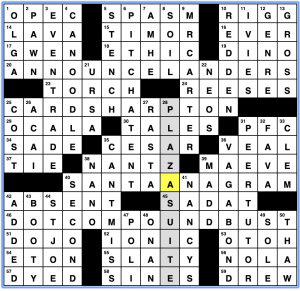
There are constructors whose wavelength I know I will be on, and there is Byron Walden. I like his puzzles! Today’s NYT was delightful! It also took me longer than expected because the way his brain clues and the way my brain solves clues are never to meet. That said, I was right on track with what would be happening with the theme answers in “Putting on Some Weight”:
- 20A: Report arriving planes over the PA system? — ANNOUNCE LANDERS
- 25A: Check Reverend Al’s ID? — CARD SHARPTON
- 40A: SATAN? — SANTA ANAGRAM
- 46A: Raid where a cult of pointillists is hiding? — DOT COMPOUND BUST
You’re adding weight (or some measure of weight, anyways — we’ve got OUNCE, TON, GRAM, and POUND, almost all of which my kitchen scale covers as options) to the end of one of the words in an otherwise standard name or phrase (ANN LANDERS, CARD SHARP, SANTA ANA, and DOT COM BUST) and getting something new and wacky. SANTA ANAGRAM is what fell for me first.
The Avengers is one of my favorite all-time TV shows, and I’m actively mad it took me most of my solve to realize the answer to “Peel player” was Diana RIGG
As mentioned above, something about the way Byron clues just whizzes past my brain’s usual ability to recognize things I otherwise know. “Training space that may have taiko drums” made me think sumo something-or-other rather than DOJO. “Foul aura” made me think MIASMA rather than the clearly better (for that grid space) STENCH! I kept trying to make NANO (again, clearly correct for a numerical prefix meaning dwarf!) be NINE, which only fits the “numerical” part of that particular equation. Ah well.
3.75/5 stars.
George Jasper’s LA Times Crossword crossword – Gareth’s summary
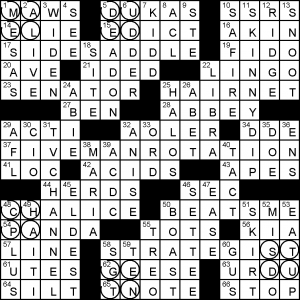
LA Times
190220
I’m not familiar with the base phrase (hah) FIVEMANROTATION, but appreciated how it’s used to create this engaging theme concept. There are five boxes are four letters, and each spells out a synonym for MAN as in “male human” – MALE, DUDE, CHAP, GENT, STUD.
Curious if others battled with the tight knot of answers in the middle left – AFL and CIO are clued circularly, so we’re left with ACTI and LOC (what? local abbreviated?) to try and dig our way out. That is where I finished the puzzle.
Remarks:
- [Stereotypical pooch], FIDO. A very old stereotype, going way back to the days of ancient Rome. Not such a common name these days, but I do see a few.
- [Cafeteria worker’s cover], HAIRNET. But snood is a much more fun word to say…
- [Many an emailer], AOLER. Feels somewhat quaint, though a lot of crossword honchos have AOL addresses still.
- [Canadian fliers], GEESE. I think this refers to Canada Geese, so Canadian seems inelegant here.
- [Language of Pakistan], URDU. Not a native language, since it’s a variant of Hindustani, nor the most spoken, but its lingua franca inherited from the days of the Raj and even before. Punjabi is the most spoken native language of Pakistan.
3,5 Stars
Gareth
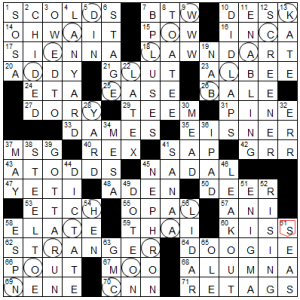
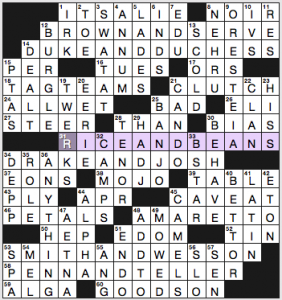
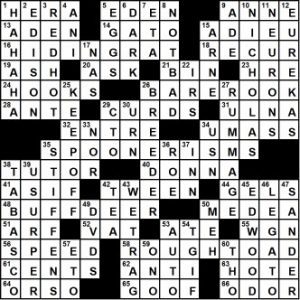
NYT: I knew Mark GOODSON from a throwaway line in the end credits of a podcast. Until now I had just assumed I was unaware of current game shows.
NYT: I really enjoyed this theme as well.
I think “Brown and Serve” should be clued with frozen breakfast sausages.
Mojo is such a great concept! It makes me think that I need to get my mojo working today for a delicate negotiation. Thanks for the reminder!
What a great week it’s been so far!
I agree; “brown and serve” didn’t seem like rolls. But I loved this puzzle, especially the unusual (for a Wednesday) grid. My solve path was more of a random walk than a linear excursion.
I agree about the week in puzzles, too.
Huda, I wish you good mojo!
Brown and serve rolls are iconic. Sausages? Not so much.
A two-Byron day is a good day.
+1
UC review: ILSA? In Language [something] [something] ?
In (the) Language, Stand Alone
Loved the NYT puzzle. Not used to unusual happily doable crosswords by Byron.
LAT: I guess my online research abilities are failing. Any references for FIDO and ROME return Georgia. Can someone cite a usage prior to A. Lincoln’s dog? Thanks.
AVX: you don’t want to know how long I tried to convince myself that ELAND was an obscure unit of weight shoved into ANNOUNCERS…
Re LATimes clue of “Canadian fliers” for GEESE – While Gareth finds “Canadian” inelegant because they are Canada Geese, I have ALWAYS heard these birds called “Canadian Geese.” BTW, I’ve always lived in the Upper Midwest where the birds are plentiful.